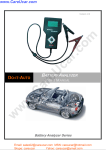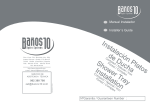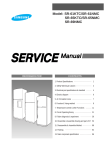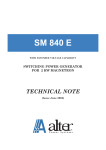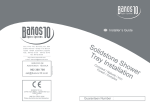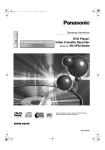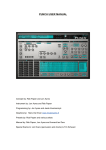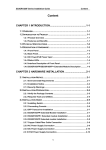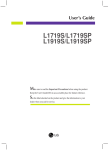Download The SuperStar SS3 Manual
Transcript
CONTENTS S.bPE R,S'fM AM/FM 10 Meter Amateur Mobile Transceiver , PA EDEL/9H k 08 &M Orr d, Specifications ................................... PAGE 2 Installation .............................. ...... 3 Location ...................................... Mounting The Radio ............................ Ignition Noise Interference ....................... Antenna ..................................... Tuning The Antenna for Optimum SWR ............. External Speaker ............................... 3 3 4 4 S S ASO Operation ..................................... SUPER STAR 3 User's Manual 7 Front Panel ................................. Rear Panel ....................................8 Procedure to Receive And Transmit ................S Alternate Microphone And Installation ..............10 SPECIFICATIONS INSTALLATION LOCATION GENERAL Model Frequency Range Emission Frequency Control Frequency Stability Temperature Range Antenna Impedance Antenna Connectors Input Voltage S12e Weight SUPER STAR 3 28.015 —. 28.465 MHz AM/FM Phase-Lock-loop (I'LL) Synthesizer 01001% 201C to +50'C 50 Ohms Standard S0-239 type 13.8V DC 190 (W) a 120 (D) x 31(H) nVrn 1 kg. TRANSMITTER RE Power Output Spurious Emission Audio Distortion Frequency Response Microphone FM: 4W, AM: 4W (PEP) More than -60 dB <10% 300 to 2500 Hu Piezoelectric Mb RECEIVER Sensitivity Squelch Sensitivity Image Rejection Audio Power Output Audio Response AM: 0.5 uV for 10dB Stnad FM: 0.5 eV for 20dB Sitad <05 all More than 80 00 3W @10% Distortion 300 102500 Hz cPucTins umeco,, CHJI -2- Plan the location of the transceiver and microphone bracket before startIng the Installation. Select a location that is convenient for operation and does not interfere with the drive or passengers in the automobiles, the transceiver Is usually mounted the dash panel with the mlcrophn bracket beside It MOUNTING THE RADIO The transcever is supplied with a universal mounting bracket When mounting the bracket and radio to your car, make sure 9 Is mechanically strong. In addition, pwvlde a good electrical connection to the chassis of the vehicle. Proceed as follows to mount the transceiver: I. After you have determined the most convenient location in your vehicle, hold the transceiver with mounting bracket in the exact location desired, it nothing will Interfere with mounting it in the desired position remove the mounting bolts. Before drilling the holes, make sure nothing will Interfere with the Installation of the mounting bolts. 2. Connect the antenna cable plug to the standard receptacle on the rear panel.. Most transceiver antennas are terminated with a type PL-259 plug and mote with the receptacle. 3. Connect the red DC power input wire (with the fuse) to +13.BV DC. This wire extends from the rear panel. In automobile installation, +13.8V DC Is usually obtained troni the accessory contact on the ignition switch. This prevent the set being left on accidentally when The driver leaves the car and also permits operating the unit without the engine running, Locate The accessory contact on most ignition switches by tracing The power We from the AM broadcast receiver In the car. 4. Connect the black lead to —13.8V DC. This Is usually the chassis of the car. Any convenient location with good electrical contact (remove paint) may be used. 5 Mount the microphone bracket on the right side of the transceiver, using two screws supplied. When mounting in an automobile, place the bracket under the dash so that microphone is readily accessible. nKlLIreunce) -3- INSTALLATION INSTALLATION IGNITION NOISE INTERFERENCE TUNING THE ANTENNA FOR OPTIMUM S.W.R Use of a molafle receiver at tow signal levels Is normally limited by the presence of electrical noise. The primary source of noise In automobile Installation is from the generator and Ignition system In the vehicle. Under most operating conditions, when signal level is adequate, the background noise does not present a serious problem. In addition, when extremely low-level signals are being received, the transceiver may be operated with vehicles engine turned off. The unit requires very little current and therefore will not significantly discharge the vehicles battery. In some installation. ignition Interference may be high enough to make good communications Impossible. The electrical noise may canoe tram several sources. Many possibilities exist, as variations between vehicles require different solutions to redact the noise, ANTENNA Since there Is such a wide variety of a base and mobile antenna, this section wIll strictly concern itseti to the various types of mobile adjustable antennas. Because the antenna length is directly related to the channel frequency, It oust be tuned to resonate optimally on all channels of the transceiver. Channel 1 requires a longer antenna than Channel 40 because t Is lower In Its frequency of operation. Due to the various methods of adjusting antennas for proper S.W.R. we have chosen what we think Is the optimum method: A. Antenna with adjustment screws (set screws), 1. Starts with the antenna extended and tighten the setscrew lightly trough so that the antenna can be lightly tapped with your finger for easy adjustment. A vertically polarized, quarter-wavelength whip antenna provides the most reliable operation and greatest range. Shorter, loaded-type whip antennas are more attractive, compact and advocate for applications where the maximum possible distance Is not required. In addition, loaded whips do not present the problems of high wind resistant imposed by a full quarterwavelength whip. Set your transceiver to Channel 20. Press the P11' (push-to-talk) switch, and tap the antenna (making It Shorter). The S.W.R meter will show a lower reading each time time antenna Is lapped. By continuing to shorten the antenna, you will notice the S.W.R reading will reach a low point and then start rising again. This means that you have passed the optimum point for Channel 20. Mobile wtdp antennas uttlite the metal body of the vehicle as a ground plane. When mounted at a corner of the vehicle they are slightly directional, In the direction of the body of the vehicle. For all practical purpose, however, the radiation pattern Is non-directional. The slight directional characteristic will be observed only at extreme distances. A standard antenna connector (type 50.239) Is provided on the transceiver far easy connection to a standard PL-259 cable termination. Extend the antenna a short distance and again follow the procedure above. When the lowest point has been reached switch to Channel I and then to Channel 40 and compare S.WR readings. They should be almost equal, If the transceiver is not mourned on a metal surface, it Is necessary to run a separate ground wire from the unit to good metal electrical ground In the vehicle. When Installed In a boat, the transceiver will not operate at maximum efficiency without a ground plate, unless the vessel has a steel hull. Before Installing the transceiver In a boat, consult your dealef for information regarding an adequate grounding system and prevention of electrolysis between fittings in the hull and water. NOTE The proper selling is achieved when the SWR is 1.5 or I below, and when it has similar reading For channels I and 40. B. Antennas which must be cut to proper length 1. F011ow the same procedure as above but adjust the length by cutting In 1/9" Increments until a good match Is obtained. 2. Be very careful not to corE 100 much at one time, as once It Is cut, It can no longer be lengthened. 3. The whip Is easily cut by filing a notch all the way around and breaking the piece elf with pliers, -4- .5- INSTALLATION 4, It you are having difficulties in adjusting your antenna, chectihe following: a. All doors must be closed when adjusting the antenna b. Make sure the antenna base is grounded. c. Check your coaxial cable routing (It may be pinched when routed Into the can) d. 'try a different location in your car (keeping In mind the radiation pattern you wish,) e. Is the antenna perfectly vertical? I. Try a different location In your neighborhood. Stay away from large metal objects when adjusting (metal telephone polls or light post, fences, etc.) OPERATION FRONT PANEL NOTE The transceiver will operate info an SWA of 2 to 1 Indefinitely and sustain an SWA 0/2: 1 fore maximum 015 minutes at rated operating conditions. 1. MICROPHONE JACK: Used to connect microphone for voice source. EXTERNAL SPEAKER The external speaker jack (EXT SP.) on the rear panel is used for remote receiver monitoring. The external speaker should have S ohms impedance and be able to handle at least 4 watts. When the external speaker is plugged in, the internal speaker is disabled. 2, ON/OFF VOLUME CONTROL: This knob controls the volume and power to the radio. To turn radio on, rotate the knob clockwise, Turning the knob further will increase the volume of the receiver. 3. ASOJSOUELCH CONTROL: This knob Is used to select one of the two leatsires: ASO (Auto Squelch) or Squelch. Squelch eliminates background noise being heard from the speaker, which can be disturbing when no transmissions are being received through the receiver. To use this feature, turn the knob fully counterclockwise and then slowly turn clockwise until the background noise is just eliminated. Further clockwise rotation will Increase the threshold level that a signal must overcome in order to be heard. Only strong signals will be heard at a maximum clockwise setting, ASQ starts off weak transmissions and unwanted noise due to terrain and conditions, it slightly retiuces the maxImum range at which signals can be heard. 4. BAND SELECTOR: This switch selects A, B, C, I), E, or F band of operation. S. CHANNEl. SELECTOR; This switch is used to select the desired transmit and receive channel. 6- 6. PA/CB SWITCH: Select the mode of operation. In the PA position, the radio acts as public address amplifier. Your voice will come out of the speaker that Is plugged into the PA. SF, 7. Jack on the rear panel. The radio does not operate when you arein the PA mode. in the 08 position, the PA function Is disabled and the radio will transmit and receive on the speaker that is connected. 7. MODE SWITCH: This switch allows you to select one of following operating modes: AM or FM 8. CH19JOFF SWITCH: Channel 19 switch Is used for instant access to Information channel ig. 9. S/HF INDICATOR: Allows the user to monitor the signal strength and HF power output level. When in low level, the $/HF indicator will be light green, When in high level, the S/HF Indicator will be light red. 10.CHANNEL DISPLAY: The channel display Indicates the current selected channel, 11.TX LED: The red LED Indicates the unit Is in the transmit rends. REAR PANEL 3. PA SP: This lack IS for PA operation. Before operating, you must first connect an external PA speaker (B ohm, 4W) to this Jack. 4. EXT. SP: This Jack accepts a 4 to 8 Ohm, 5-watt external speaker. When the external speaker Is connected to this jack, the built-in speaker will be disabled. PROCEDURE TO RECEIVE AND TRANSMIT A. MICROPHONE The ush--m-talk switch or ine microphone controls the receiver and tranemidar, Press the switch the transmitter Is activated, release switch to receive. When transmitting, hold the microphone two Inches from the mouth and speak clearly in a normal voice. This transceiver comes complete with a low impedance piezoelectric microphone. B. PROCEDURE TO RECEIVE 1. Be sure that power source, microphone and antenna are connected to the proper connectors before going to the next step. 2. Turn VOL knob clockwise to apply power to the radio, 1 Set the VOL for a comfortable listening level. :_. r" •;;:4I¼ •IIuIuII ___ aE IN TAI 4. Set the MODE switch to the desired mode. 5. Listen to the background noise from the speaker. Turn the SO knob slowly clockwise until the noise Just disappears. The SO is now property adjusted. The receiver will remaIn quint until a signal Is actually received. Do not advance the control too for as weaker signals may not be heard. 6. Set the CHANNEL selector Switch to the desired channel. C. PROCEDURE TO TRANSMIT 1. Select the desired channel of transmission I. ANTENNA: This lack accepts a 50 ohm coaxial cable with a PL-289 type plug. 2. If the channel Is clear, press the push-to-talk switch on the microphone and speak In a normal voice. 2. DC POWER: This lack accepts the 1 3.8V DC power cable with built-in fuse. The power cord provided with the radio has a black and red wire, The black goes to negative and red 9005 to positive. -8- .9. OPERATION OPERATION Before beginning the actual wiring, road carefully the circuit and wiring information provided ALTERNATE MICROPHONES AND INSTALLATION For best resus. the user should select a law-imcdocce dynamic type microphone or a transistorized microphone. The microphones must be provided with a four-lead cable. The audio conductor and Its shielded lead comprise two of the leads. The third lead Is for transmit control and fourth is for receiving Control with the microphone you select. Use the minimum heat required in soldering the coSnectlons. Keep the exposed who lengths to a minimum to avoid shorting when the microphone plug is reassembled. KNURLED sires HOUSING The microphone should provide the functions shown in the schematic below 4 WIRE MIC CABLE Pin Number Mic Cable Lead PIN RECEPTACLE —/ RETAINING SCOEW Audio Shield - 2 Audio Lead 3 Transmit Control 4 Receive Control IE7rL~ CLANP A. MICROPHONE CONNECTOR ASSEMOLY WASHER B. MICROPHONE CONNECTOR DISASSEMBLED FOR WIRING MIC Fig. 1 Microphone Sctietrlalic If the microphone to be used is provided with pre-cut leads, they roust be revised as follows. FIR. a Microphone plug wiring To wire the microphone cable to the plug provided, proceed as follows: 1. Remove the retaining screw. 2. 1. Cut leads so that they extend 7/161 beyond the plastic insulating jacket of the microphone cable. 2. All leads Should be cut to the same length. Strip the ends of each wire 1/81, and dn the exposed wire. -ID. caute RETAINER SCREW(2) Unscrew the housing from the pin receptacle body. 3, Loosen the two cable clamp retainer screws. 4. Feed the microphone cable through the housing, knurled ring and washer as shown In Figure 2. -11. OPERATION 5, The wires roust now be soldered to the pins as indicated In the above wiring tables, If vise or clamping tool in available it Should be used to hold the pin receptacle body during the soldering operation, so that both hands are free to perform the soldering. If a vise or clamping tool is not available, the pin receptacle body can be held In a stationary position by inserting it Into the microphone lack on the front panel. The numbers of the microphone plug are shown in Fig. 3, as viewed from the back of tine pug. Before soldering the wire to the pins, pre-tin the wire receptacle of each pin of the plug. OPERATION 9. The two cable clamp retainer screws should now be tightanso to secure the housing to the microphone cord. If the cutting directions have been carefully followed, the cable clamp should secure to the insulation Jacket of the microphone cable. 10.Upon completion at the microphone plug wiring, connect and secure the microphone plug In the transceiver. Fig. 3 Microphone plug pin numbers viewed from rear of pin receptacle. 6. Be sure that the housing and the knurled ring of Figure 2 are pushed back onto the microphone cable before starting to solder. It the washer Is not captive to the pin receptacle body, make sum that It is placed on the threaded portion of the pin receptacle body before soldering. 7. If the microphone lack is used to hold the pin receptacle during soldering operation, best results are obtained when the connections to pin I and 3 are made first and then the connections to pins 2 and 4. Use a minimum amount of soldering and be careful to prevent excessive solder accumulation on pins, which could cause a snort between the pin and the microphone plug housing, B. When all soldering connections to the pins of the microphone are completed, push the knurled ring and the housing forward and screw the housing onto the threaded portion of the pin receptacle body, Note the location of the screw clearance hole in the plug housing with respect to the threaded hole in the pin receptacle body. When the housing is completely threaded into the pin receptacle body, a final fraction of a turn either clockwise or counterclockwise may be required to align the screw hole with the threaded hole in the pin receptacle body. When these are aligned, the retaining screw is then screwed into place to secure the housing to the pin receptacle body. -12-13-









